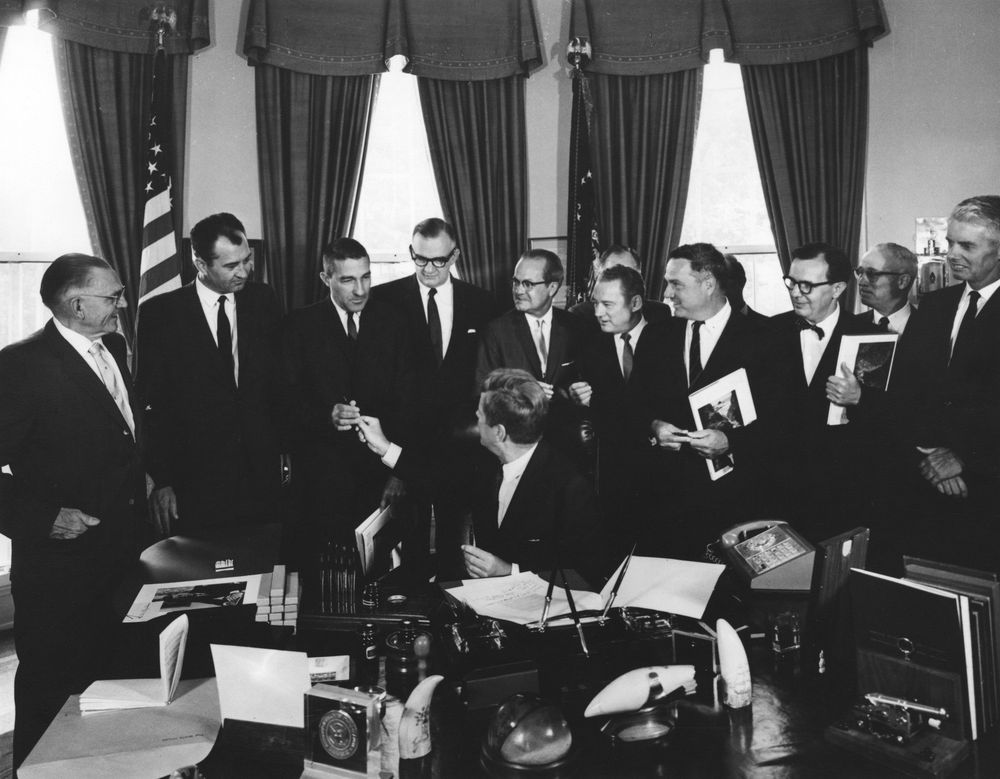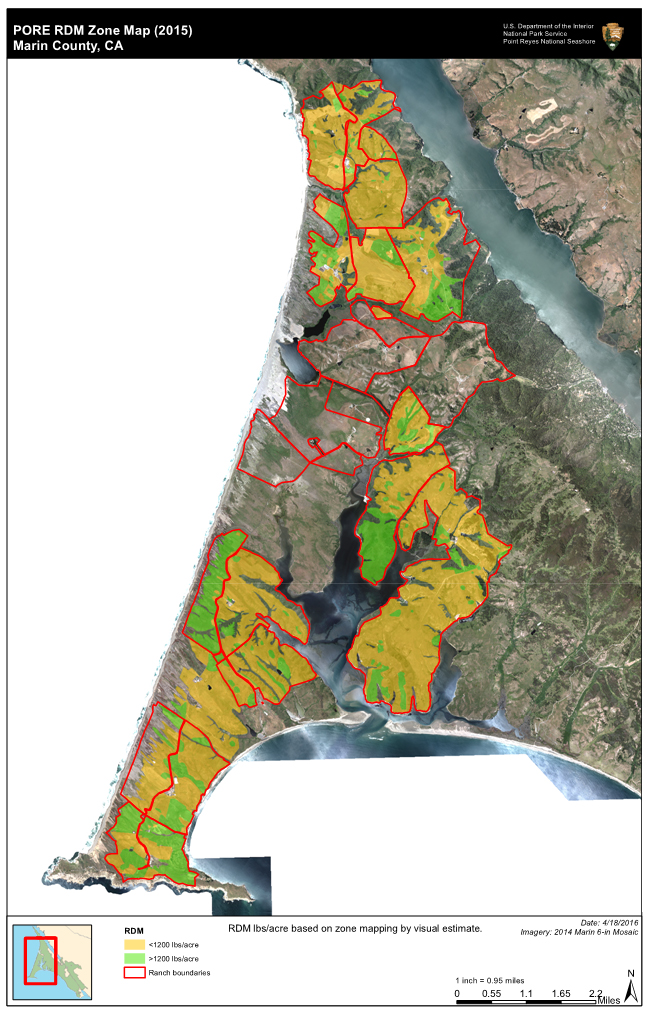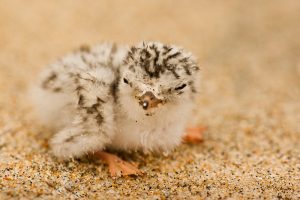Myths persist about the “rights” ranchers on the Point Reyes Peninsula. What exactly was the deal when they sold their land to the United States government to establish the National Seashore more than a half century ago? What are the impacts and management challenges of ongoing commercial ranching at this national park? The information below was sourced from National Park Service and other government records and research.
Myth: Ranchers were granted permanent rights to raise their cattle at Point Reyes National Seashore.
Fact: The legislation authorizing the establishment of the National Seashore did not mandate that the land remain in agricultural use.More By the 1990s, the ROPs began to expire and ranch families were moved to 5-year leases by then Superintendent John Sansing. To date, the Secretary of the Interior has continued to allow ranching and dairying through five- and ten-year grazing leases and “letters of agreement” which do not require an Environmental Impact Statement (EIS). In this way, commercial agriculture has continued in the park for 50 years—without considering the impacts to the park. Myth: The legislation authorizing the establishment of the National Seashore provided that ranching would always continue or at least Congress intended that ranching would always continue. Fact: There is nothing in the original legislation or in any amendment requiring that ranching continue. The words of the statute are the beginning and end of Congressional intent unless there is some ambiguity as to what any words mean and there is no such ambiguity. More In 1978, sixteen years after the park had been established and all, or virtually all, of the ranches had been acquired, Congress amended the Seashore statute to provide that “[w]here appropriate in the discretion of the Secretary, he or she may lease federally owned land . . . which was agricultural land prior to its acquisition. Such lease shall be subject to such restrictive covenants as may be necessary to carry out the purposes of . . . [this law].” 92 Stat. 3467 (1978). Thus, the Secretary has the authority, where appropriate, to authorize ranching or to prohibit ranching. However, in making that decision, the Secretary must follow another provision in the statue enacted two years earlier which states that the Seashore “shall be administered by the Secretary without impairment of its natural values, in a manner which provides for such recreational, educational, historic preservation, interpretation and scientific research opportunities as are consistent with, based upon, and supportive of the maximum protection, restoration, and preservation of the natural environment of the area . . . .” (Emphasis added.) 90 Stat. 2515. Furthermore, the 1916 NPS Organic Act, which applies to all units of the National Park System, requires NPS to conserve the scenery, wildlife, and other natural resources, to provide for the public’s enjoyment of such resources, and to leave such resources “unimpaired for the enjoyment of future generations” by prohibiting uses that cause “unacceptable impacts.” 54 U.S.C. § 100101(a). It also provides that grazing can be authorized only when such use is not detrimental to the primary purpose for which the park unit was created. 54 U.S.C. § 102101(a)(2). In summary, ranching isn’t required and Congress only intended that it be allowed to the extent it doesn’t impair natural values or resources. Myth: Ranchers got a raw deal when they sold their land to NPS and deserve to stay on in the park. Fact: Between 1962 and 1978, 27 ranches were purchased for the newly created Point Reyes National Seashore. Ranchers were paid $57 million for their land— equivalent to more than $380 million today, (calculated based on dollar values in 1970.More Myth: Ranchers claim they worked arm-in-arm with environmental groups like the Sierra Club to make the creation of Point Reyes National Seashore possible. Fact: Point Reyes ranchers actively opposed the creation of Point Reyes National Seashore, which Sierra Club actively supported.More In 1961, twelve ranchers from Point Reyes submitted written and spoken testimony to the House of Representative’s Congressional Subcommittee on National Parks of the Committee on Interior and Insular Affairs to voice their opposition the creation of Point Reyes National Seashore. At that same Congressional hearing, Marin County resident, George Collins, representing the Sierra Club, testified in favor of the proposed national seashore. David Brower, then-Director of Sierra Club, which tirelessly promoted the creation of the Point Reyes Seashore, attended the signing of the legislation at the White House, Oval Office, September 13,1962 Oval Office Public Domain, Courtesy JFK Library President John F. Kennedy (seated at desk) signs S. 476, a bill to establish the Point Reyes National Seashore in California. Standing (L-R): Representative Wayne N. Aspinall (Colorado); Representative J. T. Rutherford (Texas); Senator Hubert H. Humphrey of Minnesota (in back); Secretary of the Interior, Stewart Udall; Representative John P. Saylor (Pennsylvania); Senator Alan Bible (Nevada); Senator Clair Engle (California); Representative Clem Miller (California); unidentified (in back, mostly hidden); Representative Jeffery Cohelan (California); unidentified (in back); Executive Director of the Sierra Club, David Brower. Myth: Ranchers can’t make improvements to their business unless they get 20-year leases and are allowed expand their operations. Fact: According to Marin Agricultural Commission, Stacey Carlsen, Marin County dairy ranches contribute $34.2 million to the local economy, with Point Reyes Seashore producing 22 percent, $7.5 million. Ranchers in the Seashore receive many benefits that ranchers outside the park do not.More Ranching at the Seashore continues to be heavily subsidized by taxpayers. Ranchers outside the park pay the costs of doing business, but ranchers inside the park get help from the NPS. Despite drastic budget cuts to the national parks, the NPS dedicates scarce staff time and financial resources Seashore ranching, including (but not limited to): The public pays such costs, even though it has had little input to either ranch- or wildlife management. It has had no choice in the matter of whether ranching even belongs on parklands decades after the public purchased them. Myth: More “flexibility” to expand agricultural activities at ranching operations will benefit the public and the Seashore. Fact: The diversification of agricultural activities at Point Reyes will create wildlife conflicts, limit public access, and further privatize the park.More Expanding commercial ranching operations and control of public resources within Point Reyes would unavoidably diminish the recreation, preservation and wildlife values for which the Seashore was established, as well as place additional demands on park management. Myth: The Seashore’s native Tule elk population impinges on ranchers’ ability to feed their cattle. NPS must manage and reduce the elk herds and install more fences to protect ranching. Fact: Domestic cattle have long had de facto protected status at the national seashore despite ongoing overgrazing, water pollution, reductions to biodiversity, and transmitting disease.More Point Reyes National Seashore is the only national park where Tule elk live. To ensure forage for private cattle, most of the elk are confined behind at fence at Tomales Point. Native to California, the elk were reintroduced to the park in 1978. Once numerous on Point Reyes peninsula, they had been extirpated by early settlers and were believed to be extinct. Point Reyes Seashore is a success story in wildlife recovery. Yet, the Tule elk at the park are routinely harassed and killed to benefit private cattle operations. Malnutrition and drought reduced the elk herd by half between 2014 and 2016. It now hovers around 400 animals. The elk are increasingly inbred, but can’t be relocated because some have tested positive for Johne’s disease, a bacterium transmitted to wildlife when cattle manure is spread on fields and also when it runs off into waterways. Johne’s disease has been documented in dairy and beef herds at Point Reyes. Myth: Working ranches are historic and educational assets at the Seashore. Fact: Ranchers have long resisted interpretation of the pastoral zone and some have installed locks preventing access to public land.More Myth: Cattle and dairy ranching at Point Reyes National Seashore is “sustainable.” Fact: “Sustainable” ranching is more than “local” or “organic.”More Myth: Seashore ranchers are models of best management practices (BMPs). Fact: The scale of ranching at Point Reyes National Seashore limits the effectiveness of best management practices and fails far short of achieve optimal or healthy land qualities.More Park regulations specify that ranching operations shall not be out of compliance for two consecutive years. The study found that RDM is consistently below required minimum standards. Prudent analysis would include the impacts of changing climatic conditions— such precipitation patterns and drought—on future range management policies at PRNS. Chronically problematic sites can be seen in the maps published in 2016 with data collected in 2014. The ranch land colored in yellow indicates these ranches are below the standard agreed upon in lessors’ contracts with the NPS. Myth: Growing crops in Point Reyes does not impact wildlife. Fact: Silage mowing at Point Reyes National Seashore has been documented to negatively impact nesting birds and small mammals, unintentionally promoting raven population growth.More In a 2015 study conducted by Point Blue Conservation Science for the NPS, researchers found that mowed silage fields in Point Reyes National Seashore did not appear to be suitable for bird nesting. The fields were mowed and scraped, leaving the majority of ground cover as bare ground with some sparse stubble remnants. Of special concern, the sandier soils at I Ranch and H Ranch had minimal regeneration throughout the summer. Additionally, overall abundance of birds on is silage pastures was lower in the post-mowing visits for all breeding focal species. In the un-mowed reference plots, however, overall abundance and species richness appeared to increase in the post- mow time period. A 2000 assessment of ranch operations at PRNS found that although egg-laying remained high, fledging rate declined. “…Causes for the decline could include predation by ravens, falcons, and disturbance by visitors or cattle…A greater risk to plovers associated with ranching is predation by common ravens, which may occur in higher numbers at PRNS than would occur in the absence of ranching. Raven populations are subsidized by feeds provided to cattle, cattle afterbirths, and improperly disposed of carcasses. Five ranches on the peninsula raise silage crops annually. Rodents and birds are killed when silage is cut, and large numbers of ravens are commonly seen feeding on these kills during silage harvest. The top three recommendations from Point Blue Conservation Science to the National Park Service regarding the >1200 acres it current leases for silage mowing: Myth: Cattle grazing in the park sequesters carbon that otherwise would contribute to climate change. Fact: Ranching and dairying operations represent the highest source of greenhouse gas emissions at Point Reyes National Seashore.More In 2008, Greenhouse gas (GHG) emissions within Point Reyes National Seashore totaled 20,239 metric tons of carbon dioxide equivalent (“MTCO2E”). Of this, 12,533 MTCO2E was budgeted to agricultural operations in the seashore—62 percent of the Point Reyes greenhouse gas budget in 2008. The NPS had set a goal of a 25 percent reduction of 2008 GHG levels from agriculture by 2016. There have not been updates since 2010 to determine if they reached this goal. As the planning for the future of the National Seashore continues, an updated assessment of GHG and current mitigation measures is needed to determine how cattle operations can best achieve reductions; whether they are achieving reductions and to what extent the ranches in the Point Reyes, and beyond, are able to achieve carbon neutral or carbon negative operations. It appears that one way to ensure a decrease in carbon emissions would be to remove cattle from these open spaces and focus on restoration to native, perennial prairies and woody vegetation, which studies show sequester more carbon than the European grasses that have replaced native grasses in the Point Reyes National Seashore’s Pastoral Zone. Myth: Spreading cattle manure increases the productivity of the land. Fact: Spreading manure on pastures spreads noxious weeds and harms wildlife.More Composting can increase soil organic content and nutrient cycling. But the commercial cattle operations at Point Reyes National Seashore produce so much manure—as much as 133,533,900¹ pounds per year—that the volume of animal waste itself is cause for concern. It its Coastal Watershed Assessment for PRNS (2013) the NPS found that spreading manure on pastures correlates with an increase in invasive and noxious weed species, as well as degradation of riparian areas and creeks. Myth: Ranch management practices at Point Reyes National Seashore curtail pollution. Fact: Studies show that Point Reyes National Seashore has some of the worst water pollution in the state of California. Cattle manure is the Seashore’s single largest source of water pollution.More Exceptionally high nitrate and ammonia and sub-optimal dissolved oxygen samples have also been identified at a number of dairy operations. Many sites in these watersheds exceeded the fecal coliform standard more than 50 percent of the time. A study in The Revelator—using this same data compiled by the USGS and the NPS—show the Point Reyes has some of the most polluted streams in the state of California. Runoff from cattle is harmful to Northern California Steelhead, a species listed as a threatened under the state’s Endangered Species Act. The NPS has no current data on salmonids in Point Reyes’ streams or on the impacts of cattle manure on endangered aquatic species within the watershed (which flows into the Drakes Estero State Marine Conservation Area). Streams and tributaries leading to Drake’s Estero, adjacent to a number of the dairies (A Ranch, B Ranch, and C Ranch), all had a significant number of dissolved oxygen samples below the optimum range, posing a threat to fish in these streams and Drake’s Estero. Myth: If not for domestic cattle grazing the national seashore, it would be overrun by weeds and scrub. Fact: Restored native coastal prairies, complete with scrub species, ensure greater biodiversity at the Seashore and improve carbon drawdown.More The northern coastal prairie, which extends into Oregon, is the most diverse type of grassland in North America. Less than one percent of California’s native grassland is still intact today. Pristine patches of this vegetation still grow at Point Reyes Seashore. Native coastal prairie is dominated by long-lived perennial bunchgrasses, such as Purple needlegrass (Stipa pulchra), California fescue (Festuca californica) and California oatgrass (Danthonia californica), which can stay green year-round with the moisture provided in the fog belt. The pastoral zone at Point Reyes Seashore, where European annual grasses have replaced native grasses, is dominated by Italian thistle, milk thistle, and poison hemlock invading pastures. By contrast, at Tomales Point, where a fence keeps elk in and cattle out, shows increasing native vegetation. Some relict areas not grazed by cattle, hold examples of relict native perennial grasses. The map shows the resurgence of native grasses after cattle grazing at Tomales Point was replaced by Tule elk. There are many reasons to restore native ecosystems, and national parks are one of the best hopes of doing so. Examples of native coastal prairies in the Bay Area that have not been grazed for decades, and show high species diversity, include: “T here is nothing so American as our national parks…. The fundamental idea behind the parks…is that the country belongs to the people, that it is in process of making for the enrichment of the lives of all of us.”

The dominant species observed in the mowed silage was Common Raven, which does not breed in these fields (as it nests on cliffs, in trees, and on structures), and is a known predator of other small mammals and nestlings. Boarman and Heinrich 1999).

https://tendancienthill.org, http://www.albanyca.org/Home/Components/FacilityDirectory/FacilityDirectory/56/1670
https://parks.smcgov.org/san-bruno-mountain-state-county-park
https://web.stanford.edu/dept/JRBP/plants/PDF/SerpentinePrairie.pdf
http://www.pointrichmond.com/pointsanpablo/pdfs/PointMolateNativePlants.pdf, http://www.pointrichmond.com/pointsanpablo/pdfs/PointMolatePlantSurvey1998.pdf, https://ebcnps.wordpress.com/2016/04/04/march-2016-conservation-committee-meeting/
https://www.ebparks.org/parks/pt_pinole/
https://www.cnpsmarin.org/experiencing-natives/itemlist/category/95-plant-communities-of-marin, https://www.marincountyparks.org/depts/pk/divisions/open-space/tiburon-ridge, http://www.tiburonopenspace.org/tiburon-ridge/, http://www.marinconservationleague.org/images/stories/pdfs/events/mcl_walk-old-st-hilarys_program_for-web.pdf, https://baynature.org/article/ring-mountain-rocks/, http://www.marinij.com/lifestyle/20180325/restore-the-native-grasslands-of-ring-mountain-more-outdoor-events
https://www.ebparks.org/parks/brooks_island/, https://www.mercurynews.com/2011/05/14/off-the-richmond-shoreline-an-island-in-time/, https://baynature.org/article/a-refuge-in-the-harbor/
http://www.ebparks.org/parks/tilden/
https://www.parks.ca.gov/?page_id=471
http://rfs-env.berkeley.edu/restoration.html
https://www.cnpsmarin.org/experiencing-natives/plant-communities-of-marin
http://www.elkhornslough.org/sloughlife/grassland-scrub.htm
https://www.nps.gov/prsf/learn/nature/coastal-prairie-serpentine-grassland-community.htm




